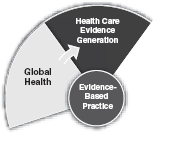The Generation of Evidence
 |
The JBI Model considers that, although the “best” evidence is derived from rigorous research, experience, expertise, inference and deduction are also important sources of evidence for healthcare policy and practice. Thus the term ‘evidence’ is used in the model to mean the basis of belief; the substantiation or confirmation that we need in order to believe that something is true. When used in relation to clinical practice, health professionals seek evidence to substantiate the worth of a very wide range of activities and interventions. This means that in each case the type of evidence needed will depend upon the nature of the activity and its purpose.
Evidence for Policy and Practice in Healthcare
Whenever health professionals engage in practice, they make numerous clinical decisions. In making such decisions, the practitioner draws on a wide range of evidence. This will include knowledge of the basic biological and behavioral sciences, the health professional’s assessment of the current context and of the individual patient; their own experience; and their own current understandings of research reports they may have recently read. All of the knowledge that is used to make a clinical decision can be referred to as evidence – and the validity of this evidence may be variable.
When making decisions, clinicians (often quite subconsciously) are frequently trying to select an appropriate activity or intervention and to assess the degree to which the decision will meet the four practice interests of health professionals; i.e. the extent to which it is:
Feasible within the context of care and the resources available;
Appropriate for the person, place and time;
Meaningful to the patient and her/his family and community; and
Effective in achieving the desired outcome;
Thus, evidence for practice takes many forms, and relates to these four practice interests of health practitioners. This is not well understood and in many countries, evidence in healthcare focuses largely on evidence of effectiveness. For example, the US allocated $1.1 Billion in
the 2009 federal budget to fund comparative effectiveness research (CER) programs. CER compares existing interventions (using a form of systematic review) to identify which is most effective. The Institute of Medicine defines CER as “the generation and synthesis of evidence that compares the benefits and harms of alternative methods to prevent, diagnose, treat, and monitor a clinical condition or to improve the delivery of care. The purpose of CER is to assist consumers, clinicians, purchasers, and policymakers to make informed decisions that will improve healthcare at both the individual and population levels” (Thill, 2010).
the 2009 federal budget to fund comparative effectiveness research (CER) programs. CER compares existing interventions (using a form of systematic review) to identify which is most effective. The Institute of Medicine defines CER as “the generation and synthesis of evidence that compares the benefits and harms of alternative methods to prevent, diagnose, treat, and monitor a clinical condition or to improve the delivery of care. The purpose of CER is to assist consumers, clinicians, purchasers, and policymakers to make informed decisions that will improve healthcare at both the individual and population levels” (Thill, 2010).
Central to CER are “pragmatic trials” – studies that measure effectiveness (Alexander & Stafford, 2009). Pearson (1998) has argued that, whilst evidence-based practice includes an interest in research directed to the establishment of effectiveness, it needs to go beyond this to include the qualitative domain. He says:
“…randomized trials are the gold standard for phenomena that we are interested in studying from a cause and effect perspective, but clearly they are not the gold standard if we are interested in how patients and nurses relate to each other, or if we are interested in how patients live through the experience of radiotherapy when they have a life threatening illness. We have yet to work out how to assess the quality of alternative approaches to research other than the RCT.”
He goes on to suggest that “… evidence-based practice is not exclusively about effectiveness; it is about basing practice on the best available evidence.”
The diverse origins of problems in healthcare practice require a diversity of research methodologies. Thus, methodological approaches in this area need to be sufficiently eclectic to incorporate classical, medical and scientific designs along with the emerging qualitative and action oriented approaches from the humanities and the social and behavioral sciences. The development of inter-disciplinary research and a greater understanding of the relationship between medical, nursing and allied health interventions are also fundamental to the emergence of research methodologies which are relevant and sensitive to the health needs of consumers.
The nature of evidence
Evidence is data or information that is used to decide whether or not a claim or view should be trusted. Although the results of well-designed research are an obvious source of evidence, the results of formal research are by no means the only data used in everyday practice. Other determinants include the patient and his/her relevant others, the practitioner’s own experiences and the nature and norms of the setting and culture in which the healthcare is being delivered. These are all rich sources of evidence to draw upon in making clinical decisions.
Stay updated, free articles. Join our Telegram channel

Full access? Get Clinical Tree


